Education and Training: Analysis of Roles and Responsibilities Report
VerifiedAdded on 2022/09/28
|17
|4253
|24
Report
AI Summary
This report delves into the multifaceted aspects of education and training, encompassing the roles and responsibilities of educators, the dynamics of teacher-student relationships, and the significance of establishing clear boundaries. It examines the crucial role of initial and diagnostic assessments in identifying individual learning goals and the implementation of referral systems to support diverse learner needs. The report explores key legislative aspects, codes of practice, and the importance of fostering appropriate behavior, equality, and diversity within educational settings. Furthermore, it investigates various assessment purposes and types, alongside a personal analysis of teaching effectiveness, communication methods, resource utilization, and inclusive learning practices. The report highlights the significance of adapting teaching strategies to meet individual learner needs, promoting equality, and valuing diversity. The conclusion summarizes the key findings and emphasizes the importance of reflective practice in enhancing teaching and learning experiences. The document is contributed by a student to be published on the website Desklib.
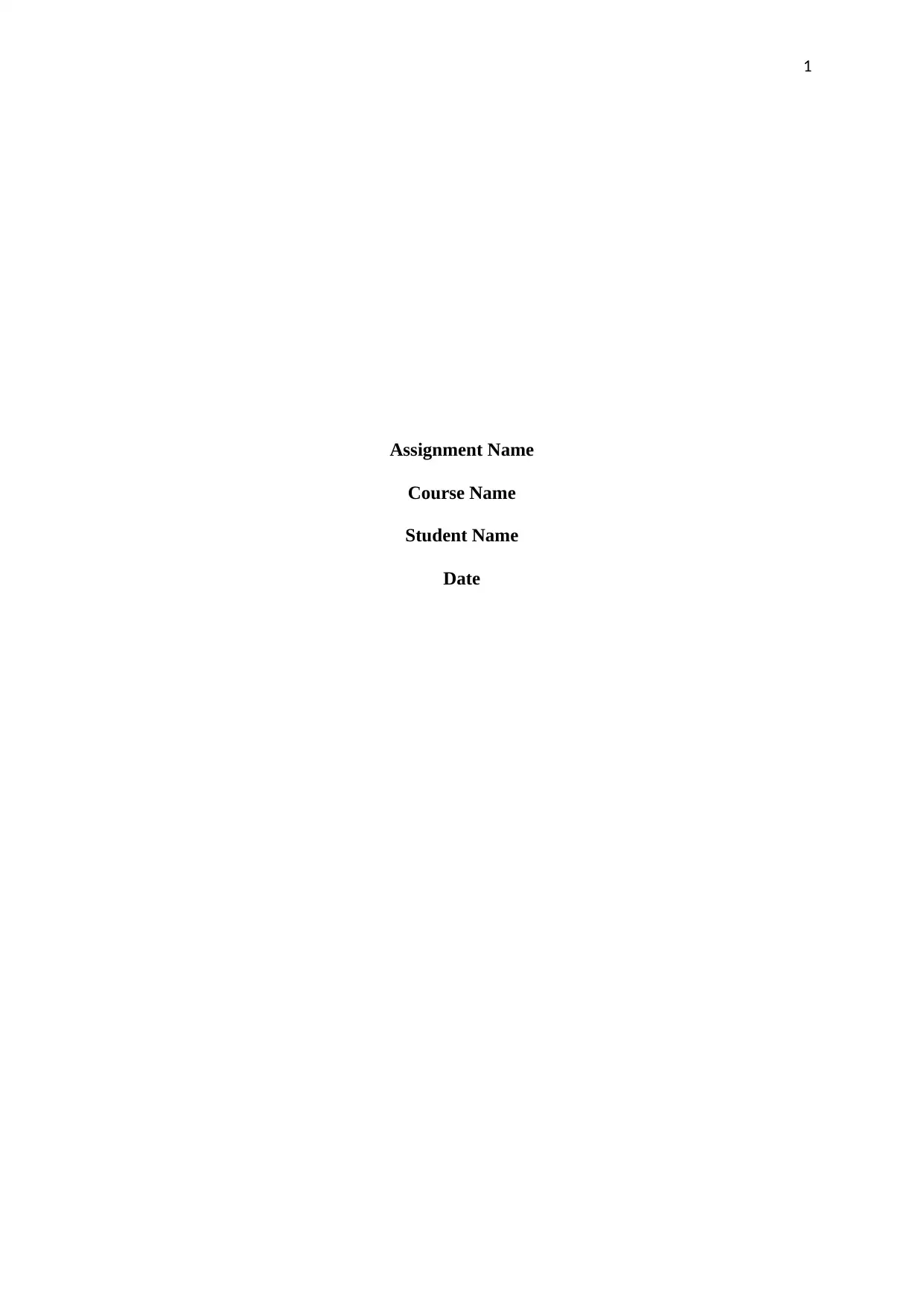
1
Assignment Name
Course Name
Student Name
Date
Assignment Name
Course Name
Student Name
Date
Paraphrase This Document
Need a fresh take? Get an instant paraphrase of this document with our AI Paraphraser
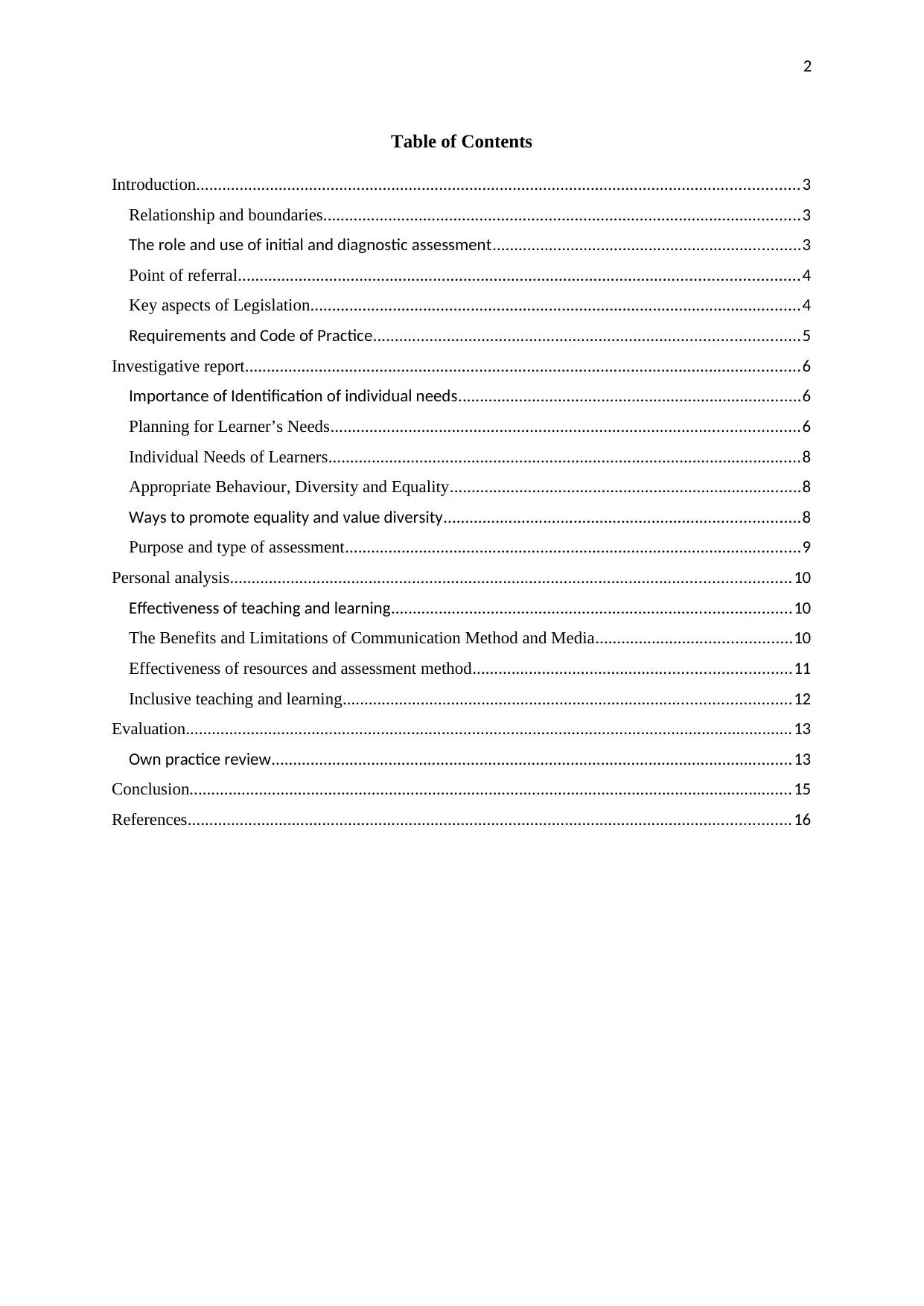
2
Table of Contents
Introduction...........................................................................................................................................3
Relationship and boundaries..............................................................................................................3
The role and use of initial and diagnostic assessment.......................................................................3
Point of referral.................................................................................................................................4
Key aspects of Legislation.................................................................................................................4
Requirements and Code of Practice..................................................................................................5
Investigative report................................................................................................................................6
Importance of Identification of individual needs...............................................................................6
Planning for Learner’s Needs............................................................................................................6
Individual Needs of Learners.............................................................................................................8
Appropriate Behaviour, Diversity and Equality.................................................................................8
Ways to promote equality and value diversity..................................................................................8
Purpose and type of assessment.........................................................................................................9
Personal analysis.................................................................................................................................10
Effectiveness of teaching and learning............................................................................................10
The Benefits and Limitations of Communication Method and Media.............................................10
Effectiveness of resources and assessment method.........................................................................11
Inclusive teaching and learning.......................................................................................................12
Evaluation............................................................................................................................................13
Own practice review........................................................................................................................13
Conclusion...........................................................................................................................................15
References...........................................................................................................................................16
Table of Contents
Introduction...........................................................................................................................................3
Relationship and boundaries..............................................................................................................3
The role and use of initial and diagnostic assessment.......................................................................3
Point of referral.................................................................................................................................4
Key aspects of Legislation.................................................................................................................4
Requirements and Code of Practice..................................................................................................5
Investigative report................................................................................................................................6
Importance of Identification of individual needs...............................................................................6
Planning for Learner’s Needs............................................................................................................6
Individual Needs of Learners.............................................................................................................8
Appropriate Behaviour, Diversity and Equality.................................................................................8
Ways to promote equality and value diversity..................................................................................8
Purpose and type of assessment.........................................................................................................9
Personal analysis.................................................................................................................................10
Effectiveness of teaching and learning............................................................................................10
The Benefits and Limitations of Communication Method and Media.............................................10
Effectiveness of resources and assessment method.........................................................................11
Inclusive teaching and learning.......................................................................................................12
Evaluation............................................................................................................................................13
Own practice review........................................................................................................................13
Conclusion...........................................................................................................................................15
References...........................................................................................................................................16
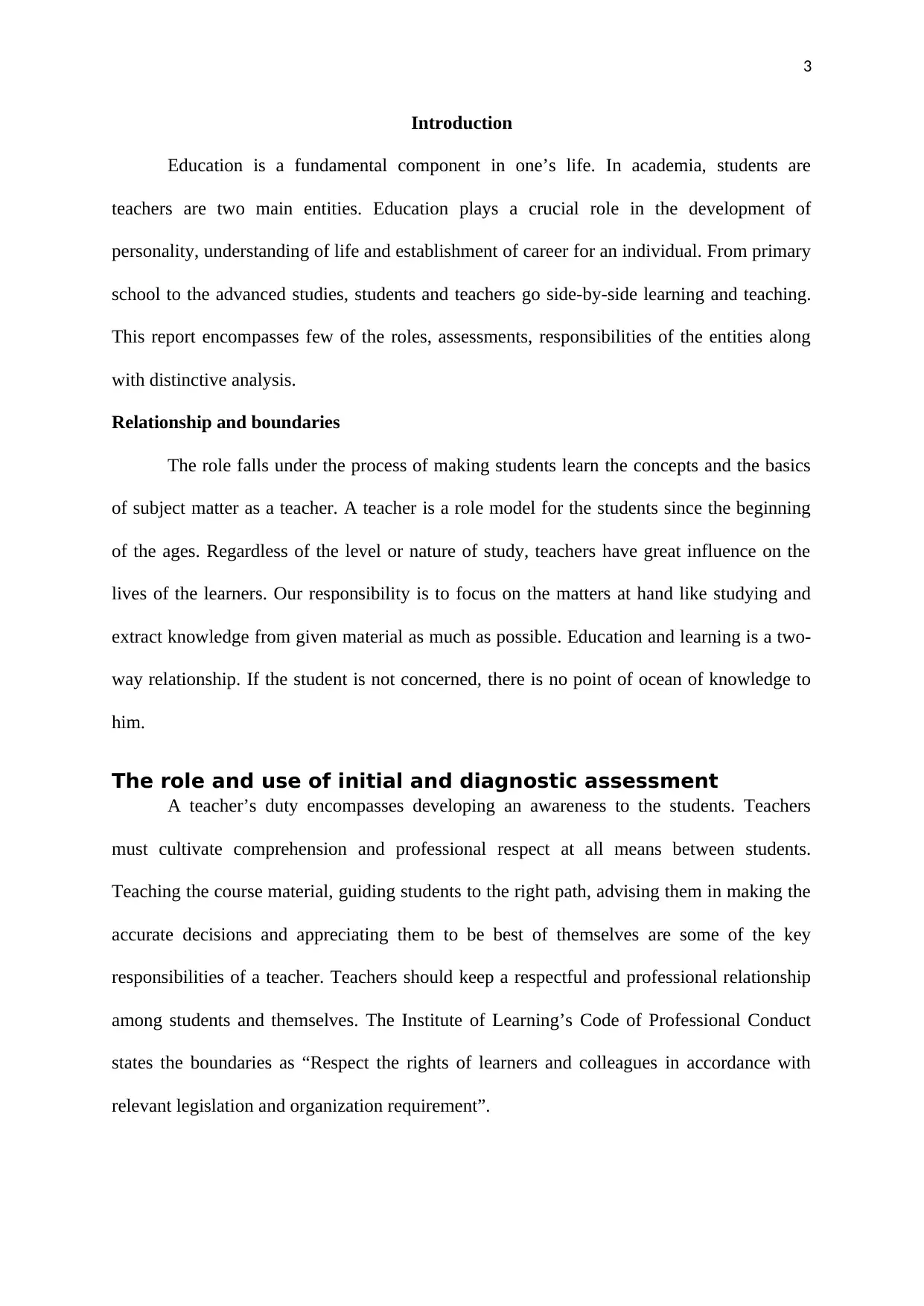
3
Introduction
Education is a fundamental component in one’s life. In academia, students are
teachers are two main entities. Education plays a crucial role in the development of
personality, understanding of life and establishment of career for an individual. From primary
school to the advanced studies, students and teachers go side-by-side learning and teaching.
This report encompasses few of the roles, assessments, responsibilities of the entities along
with distinctive analysis.
Relationship and boundaries
The role falls under the process of making students learn the concepts and the basics
of subject matter as a teacher. A teacher is a role model for the students since the beginning
of the ages. Regardless of the level or nature of study, teachers have great influence on the
lives of the learners. Our responsibility is to focus on the matters at hand like studying and
extract knowledge from given material as much as possible. Education and learning is a two-
way relationship. If the student is not concerned, there is no point of ocean of knowledge to
him.
The role and use of initial and diagnostic assessment
A teacher’s duty encompasses developing an awareness to the students. Teachers
must cultivate comprehension and professional respect at all means between students.
Teaching the course material, guiding students to the right path, advising them in making the
accurate decisions and appreciating them to be best of themselves are some of the key
responsibilities of a teacher. Teachers should keep a respectful and professional relationship
among students and themselves. The Institute of Learning’s Code of Professional Conduct
states the boundaries as “Respect the rights of learners and colleagues in accordance with
relevant legislation and organization requirement”.
Introduction
Education is a fundamental component in one’s life. In academia, students are
teachers are two main entities. Education plays a crucial role in the development of
personality, understanding of life and establishment of career for an individual. From primary
school to the advanced studies, students and teachers go side-by-side learning and teaching.
This report encompasses few of the roles, assessments, responsibilities of the entities along
with distinctive analysis.
Relationship and boundaries
The role falls under the process of making students learn the concepts and the basics
of subject matter as a teacher. A teacher is a role model for the students since the beginning
of the ages. Regardless of the level or nature of study, teachers have great influence on the
lives of the learners. Our responsibility is to focus on the matters at hand like studying and
extract knowledge from given material as much as possible. Education and learning is a two-
way relationship. If the student is not concerned, there is no point of ocean of knowledge to
him.
The role and use of initial and diagnostic assessment
A teacher’s duty encompasses developing an awareness to the students. Teachers
must cultivate comprehension and professional respect at all means between students.
Teaching the course material, guiding students to the right path, advising them in making the
accurate decisions and appreciating them to be best of themselves are some of the key
responsibilities of a teacher. Teachers should keep a respectful and professional relationship
among students and themselves. The Institute of Learning’s Code of Professional Conduct
states the boundaries as “Respect the rights of learners and colleagues in accordance with
relevant legislation and organization requirement”.
⊘ This is a preview!⊘
Do you want full access?
Subscribe today to unlock all pages.

Trusted by 1+ million students worldwide
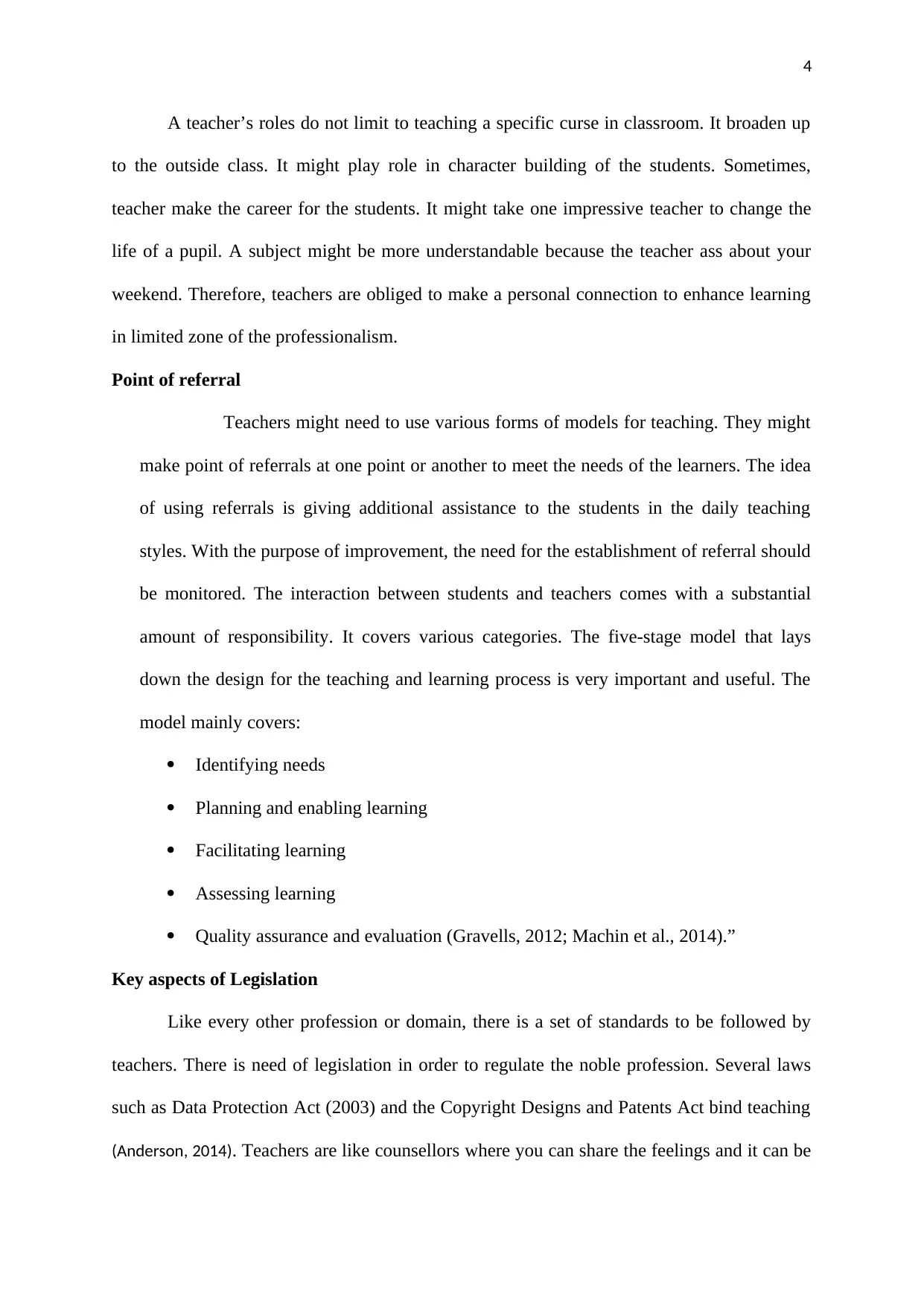
4
A teacher’s roles do not limit to teaching a specific curse in classroom. It broaden up
to the outside class. It might play role in character building of the students. Sometimes,
teacher make the career for the students. It might take one impressive teacher to change the
life of a pupil. A subject might be more understandable because the teacher ass about your
weekend. Therefore, teachers are obliged to make a personal connection to enhance learning
in limited zone of the professionalism.
Point of referral
Teachers might need to use various forms of models for teaching. They might
make point of referrals at one point or another to meet the needs of the learners. The idea
of using referrals is giving additional assistance to the students in the daily teaching
styles. With the purpose of improvement, the need for the establishment of referral should
be monitored. The interaction between students and teachers comes with a substantial
amount of responsibility. It covers various categories. The five-stage model that lays
down the design for the teaching and learning process is very important and useful. The
model mainly covers:
Identifying needs
Planning and enabling learning
Facilitating learning
Assessing learning
Quality assurance and evaluation (Gravells, 2012; Machin et al., 2014).”
Key aspects of Legislation
Like every other profession or domain, there is a set of standards to be followed by
teachers. There is need of legislation in order to regulate the noble profession. Several laws
such as Data Protection Act (2003) and the Copyright Designs and Patents Act bind teaching
(Anderson, 2014). Teachers are like counsellors where you can share the feelings and it can be
A teacher’s roles do not limit to teaching a specific curse in classroom. It broaden up
to the outside class. It might play role in character building of the students. Sometimes,
teacher make the career for the students. It might take one impressive teacher to change the
life of a pupil. A subject might be more understandable because the teacher ass about your
weekend. Therefore, teachers are obliged to make a personal connection to enhance learning
in limited zone of the professionalism.
Point of referral
Teachers might need to use various forms of models for teaching. They might
make point of referrals at one point or another to meet the needs of the learners. The idea
of using referrals is giving additional assistance to the students in the daily teaching
styles. With the purpose of improvement, the need for the establishment of referral should
be monitored. The interaction between students and teachers comes with a substantial
amount of responsibility. It covers various categories. The five-stage model that lays
down the design for the teaching and learning process is very important and useful. The
model mainly covers:
Identifying needs
Planning and enabling learning
Facilitating learning
Assessing learning
Quality assurance and evaluation (Gravells, 2012; Machin et al., 2014).”
Key aspects of Legislation
Like every other profession or domain, there is a set of standards to be followed by
teachers. There is need of legislation in order to regulate the noble profession. Several laws
such as Data Protection Act (2003) and the Copyright Designs and Patents Act bind teaching
(Anderson, 2014). Teachers are like counsellors where you can share the feelings and it can be
Paraphrase This Document
Need a fresh take? Get an instant paraphrase of this document with our AI Paraphraser
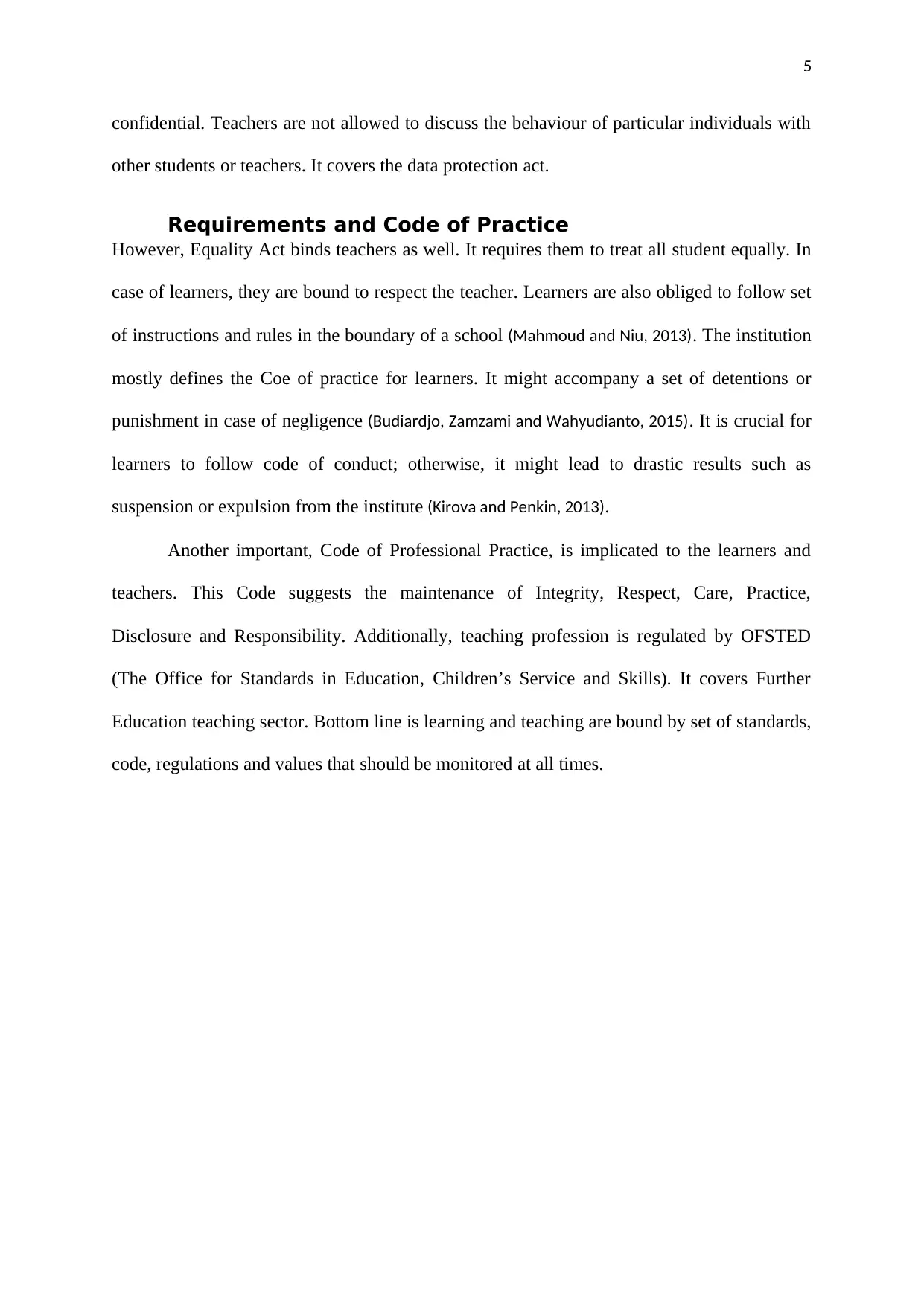
5
confidential. Teachers are not allowed to discuss the behaviour of particular individuals with
other students or teachers. It covers the data protection act.
Requirements and Code of Practice
However, Equality Act binds teachers as well. It requires them to treat all student equally. In
case of learners, they are bound to respect the teacher. Learners are also obliged to follow set
of instructions and rules in the boundary of a school (Mahmoud and Niu, 2013). The institution
mostly defines the Coe of practice for learners. It might accompany a set of detentions or
punishment in case of negligence (Budiardjo, Zamzami and Wahyudianto, 2015). It is crucial for
learners to follow code of conduct; otherwise, it might lead to drastic results such as
suspension or expulsion from the institute (Kirova and Penkin, 2013).
Another important, Code of Professional Practice, is implicated to the learners and
teachers. This Code suggests the maintenance of Integrity, Respect, Care, Practice,
Disclosure and Responsibility. Additionally, teaching profession is regulated by OFSTED
(The Office for Standards in Education, Children’s Service and Skills). It covers Further
Education teaching sector. Bottom line is learning and teaching are bound by set of standards,
code, regulations and values that should be monitored at all times.
confidential. Teachers are not allowed to discuss the behaviour of particular individuals with
other students or teachers. It covers the data protection act.
Requirements and Code of Practice
However, Equality Act binds teachers as well. It requires them to treat all student equally. In
case of learners, they are bound to respect the teacher. Learners are also obliged to follow set
of instructions and rules in the boundary of a school (Mahmoud and Niu, 2013). The institution
mostly defines the Coe of practice for learners. It might accompany a set of detentions or
punishment in case of negligence (Budiardjo, Zamzami and Wahyudianto, 2015). It is crucial for
learners to follow code of conduct; otherwise, it might lead to drastic results such as
suspension or expulsion from the institute (Kirova and Penkin, 2013).
Another important, Code of Professional Practice, is implicated to the learners and
teachers. This Code suggests the maintenance of Integrity, Respect, Care, Practice,
Disclosure and Responsibility. Additionally, teaching profession is regulated by OFSTED
(The Office for Standards in Education, Children’s Service and Skills). It covers Further
Education teaching sector. Bottom line is learning and teaching are bound by set of standards,
code, regulations and values that should be monitored at all times.
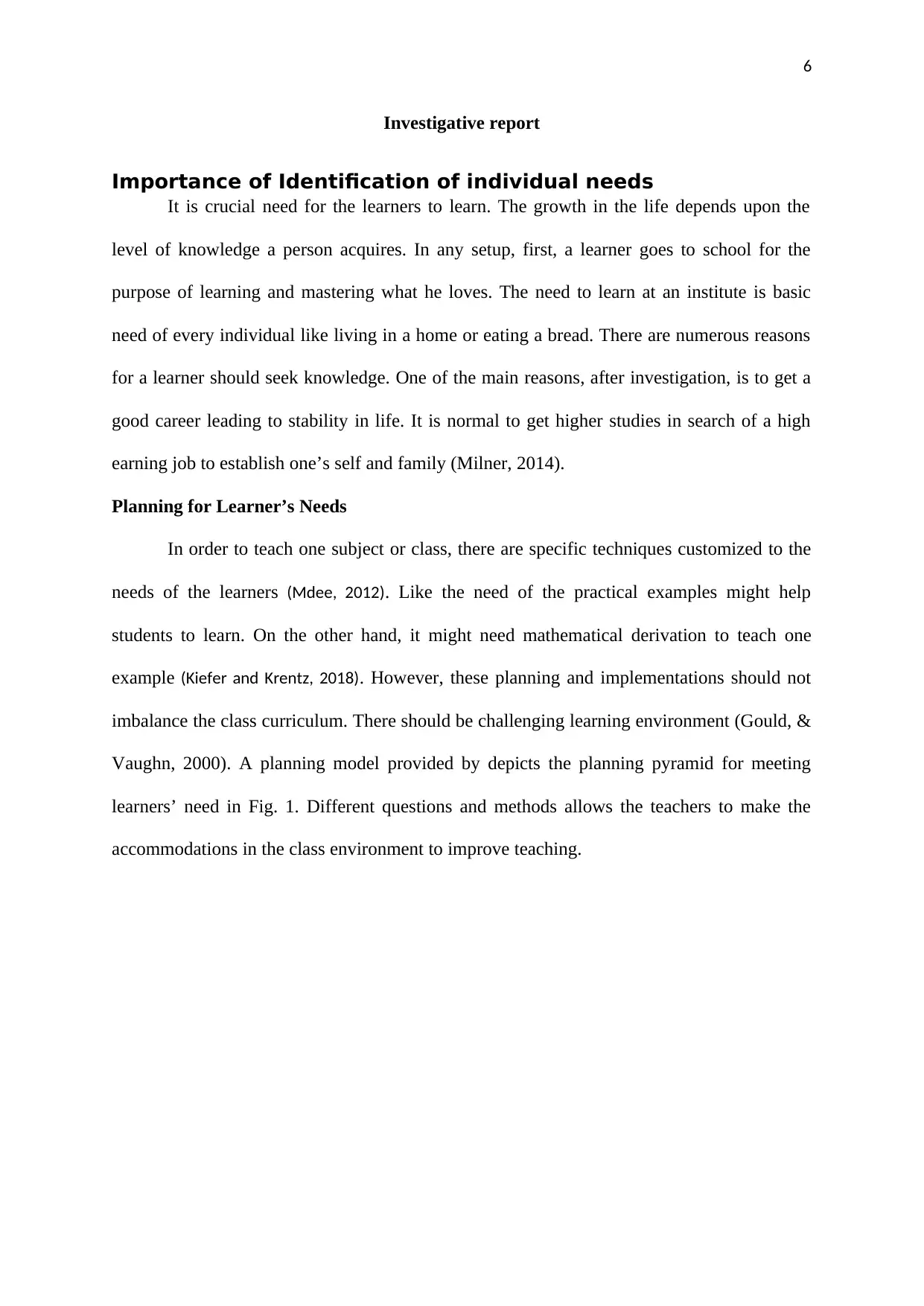
6
Investigative report
Importance of Identification of individual needs
It is crucial need for the learners to learn. The growth in the life depends upon the
level of knowledge a person acquires. In any setup, first, a learner goes to school for the
purpose of learning and mastering what he loves. The need to learn at an institute is basic
need of every individual like living in a home or eating a bread. There are numerous reasons
for a learner should seek knowledge. One of the main reasons, after investigation, is to get a
good career leading to stability in life. It is normal to get higher studies in search of a high
earning job to establish one’s self and family (Milner, 2014).
Planning for Learner’s Needs
In order to teach one subject or class, there are specific techniques customized to the
needs of the learners (Mdee, 2012). Like the need of the practical examples might help
students to learn. On the other hand, it might need mathematical derivation to teach one
example (Kiefer and Krentz, 2018). However, these planning and implementations should not
imbalance the class curriculum. There should be challenging learning environment (Gould, &
Vaughn, 2000). A planning model provided by depicts the planning pyramid for meeting
learners’ need in Fig. 1. Different questions and methods allows the teachers to make the
accommodations in the class environment to improve teaching.
Investigative report
Importance of Identification of individual needs
It is crucial need for the learners to learn. The growth in the life depends upon the
level of knowledge a person acquires. In any setup, first, a learner goes to school for the
purpose of learning and mastering what he loves. The need to learn at an institute is basic
need of every individual like living in a home or eating a bread. There are numerous reasons
for a learner should seek knowledge. One of the main reasons, after investigation, is to get a
good career leading to stability in life. It is normal to get higher studies in search of a high
earning job to establish one’s self and family (Milner, 2014).
Planning for Learner’s Needs
In order to teach one subject or class, there are specific techniques customized to the
needs of the learners (Mdee, 2012). Like the need of the practical examples might help
students to learn. On the other hand, it might need mathematical derivation to teach one
example (Kiefer and Krentz, 2018). However, these planning and implementations should not
imbalance the class curriculum. There should be challenging learning environment (Gould, &
Vaughn, 2000). A planning model provided by depicts the planning pyramid for meeting
learners’ need in Fig. 1. Different questions and methods allows the teachers to make the
accommodations in the class environment to improve teaching.
⊘ This is a preview!⊘
Do you want full access?
Subscribe today to unlock all pages.

Trusted by 1+ million students worldwide
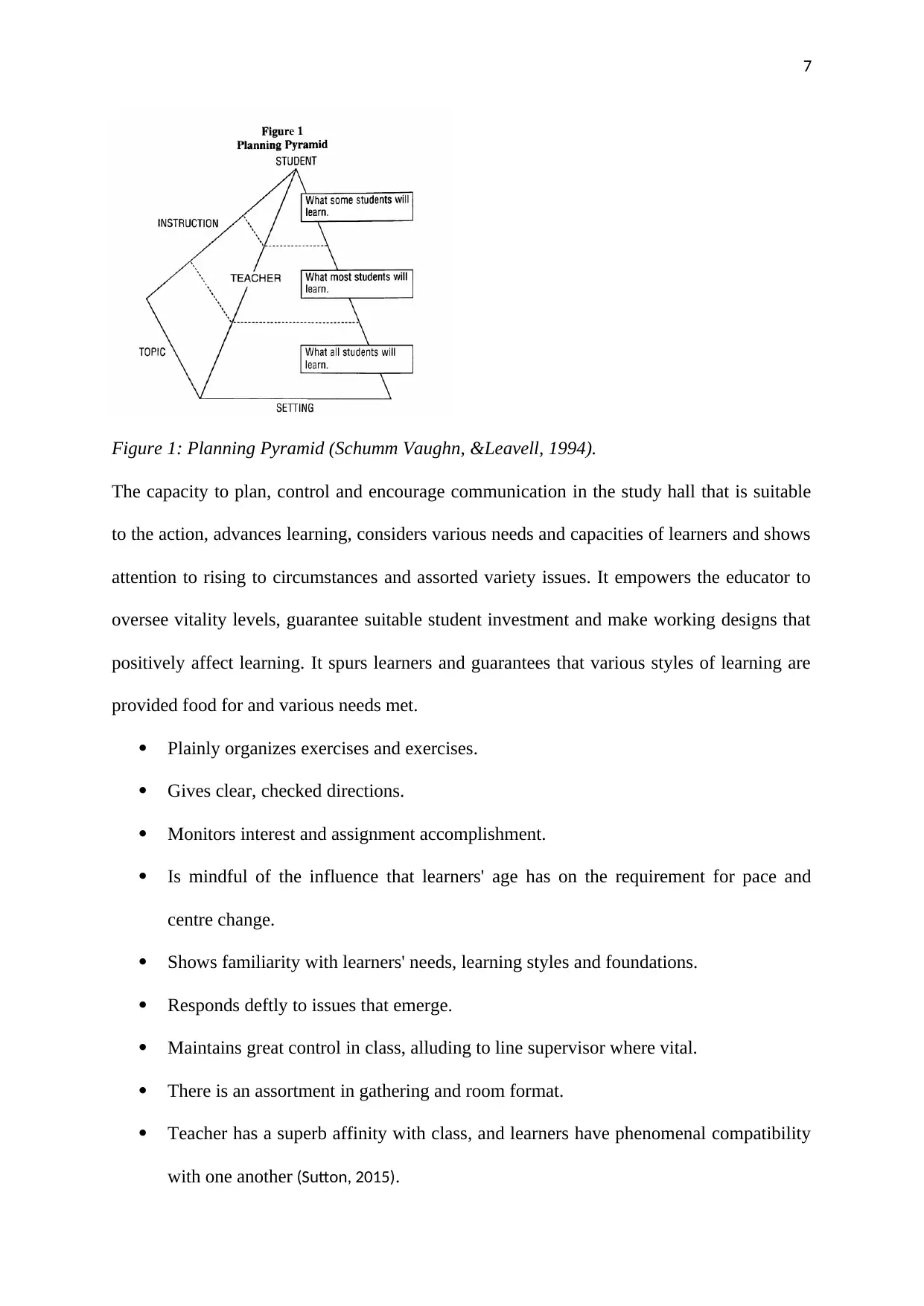
7
Figure 1: Planning Pyramid (Schumm Vaughn, &Leavell, 1994).
The capacity to plan, control and encourage communication in the study hall that is suitable
to the action, advances learning, considers various needs and capacities of learners and shows
attention to rising to circumstances and assorted variety issues. It empowers the educator to
oversee vitality levels, guarantee suitable student investment and make working designs that
positively affect learning. It spurs learners and guarantees that various styles of learning are
provided food for and various needs met.
Plainly organizes exercises and exercises.
Gives clear, checked directions.
Monitors interest and assignment accomplishment.
Is mindful of the influence that learners' age has on the requirement for pace and
centre change.
Shows familiarity with learners' needs, learning styles and foundations.
Responds deftly to issues that emerge.
Maintains great control in class, alluding to line supervisor where vital.
There is an assortment in gathering and room format.
Teacher has a superb affinity with class, and learners have phenomenal compatibility
with one another (Sutton, 2015).
Figure 1: Planning Pyramid (Schumm Vaughn, &Leavell, 1994).
The capacity to plan, control and encourage communication in the study hall that is suitable
to the action, advances learning, considers various needs and capacities of learners and shows
attention to rising to circumstances and assorted variety issues. It empowers the educator to
oversee vitality levels, guarantee suitable student investment and make working designs that
positively affect learning. It spurs learners and guarantees that various styles of learning are
provided food for and various needs met.
Plainly organizes exercises and exercises.
Gives clear, checked directions.
Monitors interest and assignment accomplishment.
Is mindful of the influence that learners' age has on the requirement for pace and
centre change.
Shows familiarity with learners' needs, learning styles and foundations.
Responds deftly to issues that emerge.
Maintains great control in class, alluding to line supervisor where vital.
There is an assortment in gathering and room format.
Teacher has a superb affinity with class, and learners have phenomenal compatibility
with one another (Sutton, 2015).
Paraphrase This Document
Need a fresh take? Get an instant paraphrase of this document with our AI Paraphraser
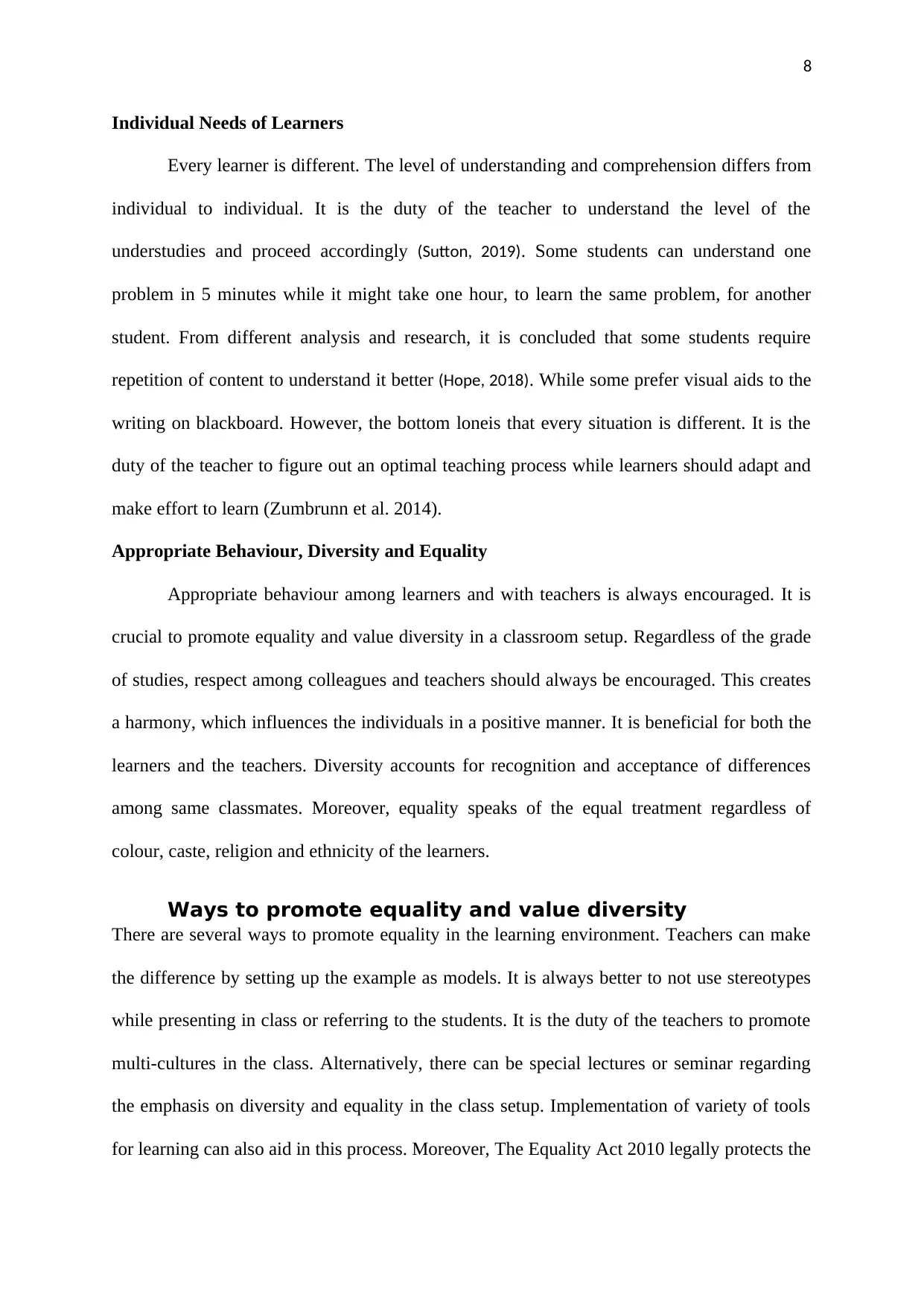
8
Individual Needs of Learners
Every learner is different. The level of understanding and comprehension differs from
individual to individual. It is the duty of the teacher to understand the level of the
understudies and proceed accordingly (Sutton, 2019). Some students can understand one
problem in 5 minutes while it might take one hour, to learn the same problem, for another
student. From different analysis and research, it is concluded that some students require
repetition of content to understand it better (Hope, 2018). While some prefer visual aids to the
writing on blackboard. However, the bottom loneis that every situation is different. It is the
duty of the teacher to figure out an optimal teaching process while learners should adapt and
make effort to learn (Zumbrunn et al. 2014).
Appropriate Behaviour, Diversity and Equality
Appropriate behaviour among learners and with teachers is always encouraged. It is
crucial to promote equality and value diversity in a classroom setup. Regardless of the grade
of studies, respect among colleagues and teachers should always be encouraged. This creates
a harmony, which influences the individuals in a positive manner. It is beneficial for both the
learners and the teachers. Diversity accounts for recognition and acceptance of differences
among same classmates. Moreover, equality speaks of the equal treatment regardless of
colour, caste, religion and ethnicity of the learners.
Ways to promote equality and value diversity
There are several ways to promote equality in the learning environment. Teachers can make
the difference by setting up the example as models. It is always better to not use stereotypes
while presenting in class or referring to the students. It is the duty of the teachers to promote
multi-cultures in the class. Alternatively, there can be special lectures or seminar regarding
the emphasis on diversity and equality in the class setup. Implementation of variety of tools
for learning can also aid in this process. Moreover, The Equality Act 2010 legally protects the
Individual Needs of Learners
Every learner is different. The level of understanding and comprehension differs from
individual to individual. It is the duty of the teacher to understand the level of the
understudies and proceed accordingly (Sutton, 2019). Some students can understand one
problem in 5 minutes while it might take one hour, to learn the same problem, for another
student. From different analysis and research, it is concluded that some students require
repetition of content to understand it better (Hope, 2018). While some prefer visual aids to the
writing on blackboard. However, the bottom loneis that every situation is different. It is the
duty of the teacher to figure out an optimal teaching process while learners should adapt and
make effort to learn (Zumbrunn et al. 2014).
Appropriate Behaviour, Diversity and Equality
Appropriate behaviour among learners and with teachers is always encouraged. It is
crucial to promote equality and value diversity in a classroom setup. Regardless of the grade
of studies, respect among colleagues and teachers should always be encouraged. This creates
a harmony, which influences the individuals in a positive manner. It is beneficial for both the
learners and the teachers. Diversity accounts for recognition and acceptance of differences
among same classmates. Moreover, equality speaks of the equal treatment regardless of
colour, caste, religion and ethnicity of the learners.
Ways to promote equality and value diversity
There are several ways to promote equality in the learning environment. Teachers can make
the difference by setting up the example as models. It is always better to not use stereotypes
while presenting in class or referring to the students. It is the duty of the teachers to promote
multi-cultures in the class. Alternatively, there can be special lectures or seminar regarding
the emphasis on diversity and equality in the class setup. Implementation of variety of tools
for learning can also aid in this process. Moreover, The Equality Act 2010 legally protects the
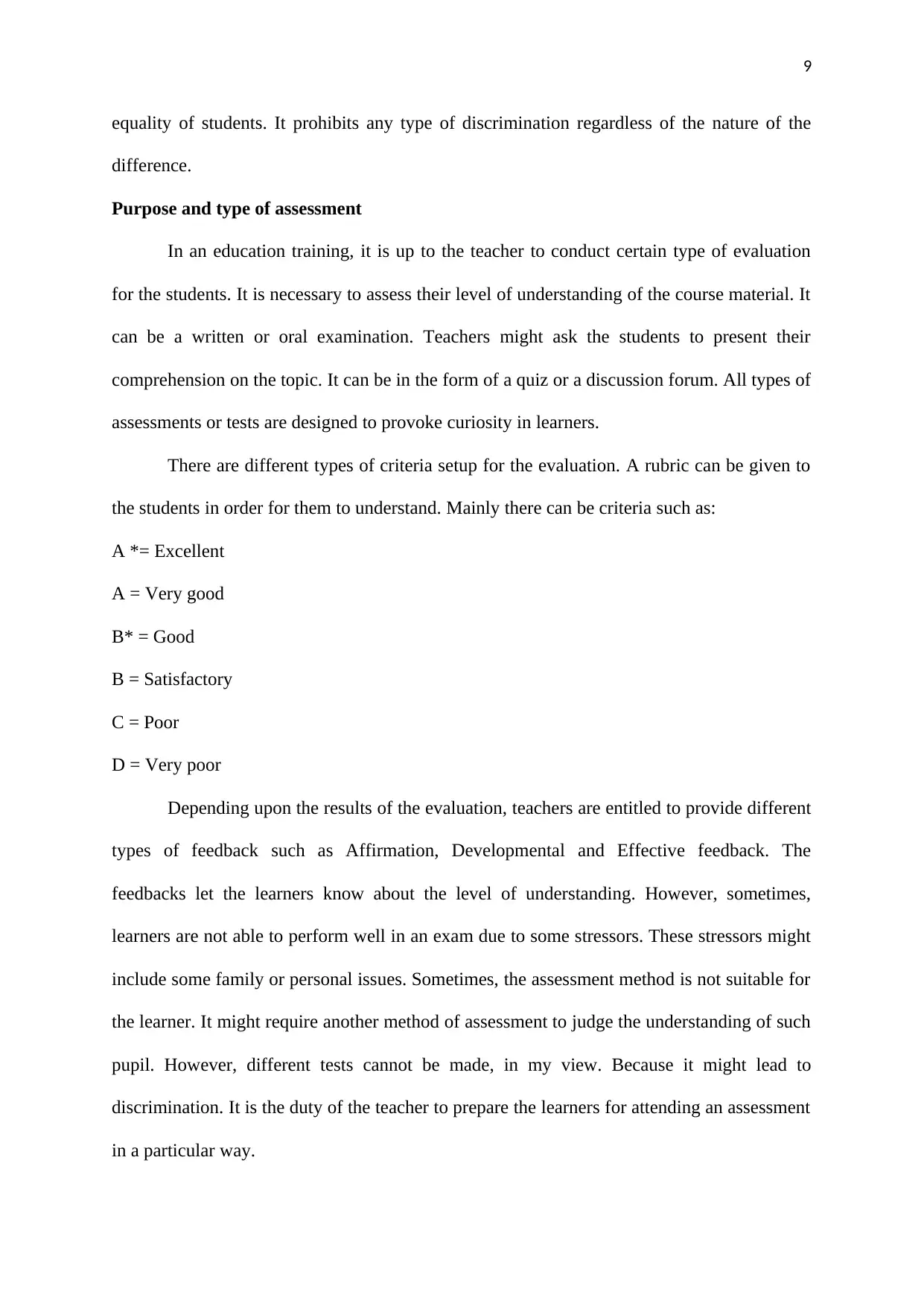
9
equality of students. It prohibits any type of discrimination regardless of the nature of the
difference.
Purpose and type of assessment
In an education training, it is up to the teacher to conduct certain type of evaluation
for the students. It is necessary to assess their level of understanding of the course material. It
can be a written or oral examination. Teachers might ask the students to present their
comprehension on the topic. It can be in the form of a quiz or a discussion forum. All types of
assessments or tests are designed to provoke curiosity in learners.
There are different types of criteria setup for the evaluation. A rubric can be given to
the students in order for them to understand. Mainly there can be criteria such as:
A *= Excellent
A = Very good
B* = Good
B = Satisfactory
C = Poor
D = Very poor
Depending upon the results of the evaluation, teachers are entitled to provide different
types of feedback such as Affirmation, Developmental and Effective feedback. The
feedbacks let the learners know about the level of understanding. However, sometimes,
learners are not able to perform well in an exam due to some stressors. These stressors might
include some family or personal issues. Sometimes, the assessment method is not suitable for
the learner. It might require another method of assessment to judge the understanding of such
pupil. However, different tests cannot be made, in my view. Because it might lead to
discrimination. It is the duty of the teacher to prepare the learners for attending an assessment
in a particular way.
equality of students. It prohibits any type of discrimination regardless of the nature of the
difference.
Purpose and type of assessment
In an education training, it is up to the teacher to conduct certain type of evaluation
for the students. It is necessary to assess their level of understanding of the course material. It
can be a written or oral examination. Teachers might ask the students to present their
comprehension on the topic. It can be in the form of a quiz or a discussion forum. All types of
assessments or tests are designed to provoke curiosity in learners.
There are different types of criteria setup for the evaluation. A rubric can be given to
the students in order for them to understand. Mainly there can be criteria such as:
A *= Excellent
A = Very good
B* = Good
B = Satisfactory
C = Poor
D = Very poor
Depending upon the results of the evaluation, teachers are entitled to provide different
types of feedback such as Affirmation, Developmental and Effective feedback. The
feedbacks let the learners know about the level of understanding. However, sometimes,
learners are not able to perform well in an exam due to some stressors. These stressors might
include some family or personal issues. Sometimes, the assessment method is not suitable for
the learner. It might require another method of assessment to judge the understanding of such
pupil. However, different tests cannot be made, in my view. Because it might lead to
discrimination. It is the duty of the teacher to prepare the learners for attending an assessment
in a particular way.
⊘ This is a preview!⊘
Do you want full access?
Subscribe today to unlock all pages.

Trusted by 1+ million students worldwide
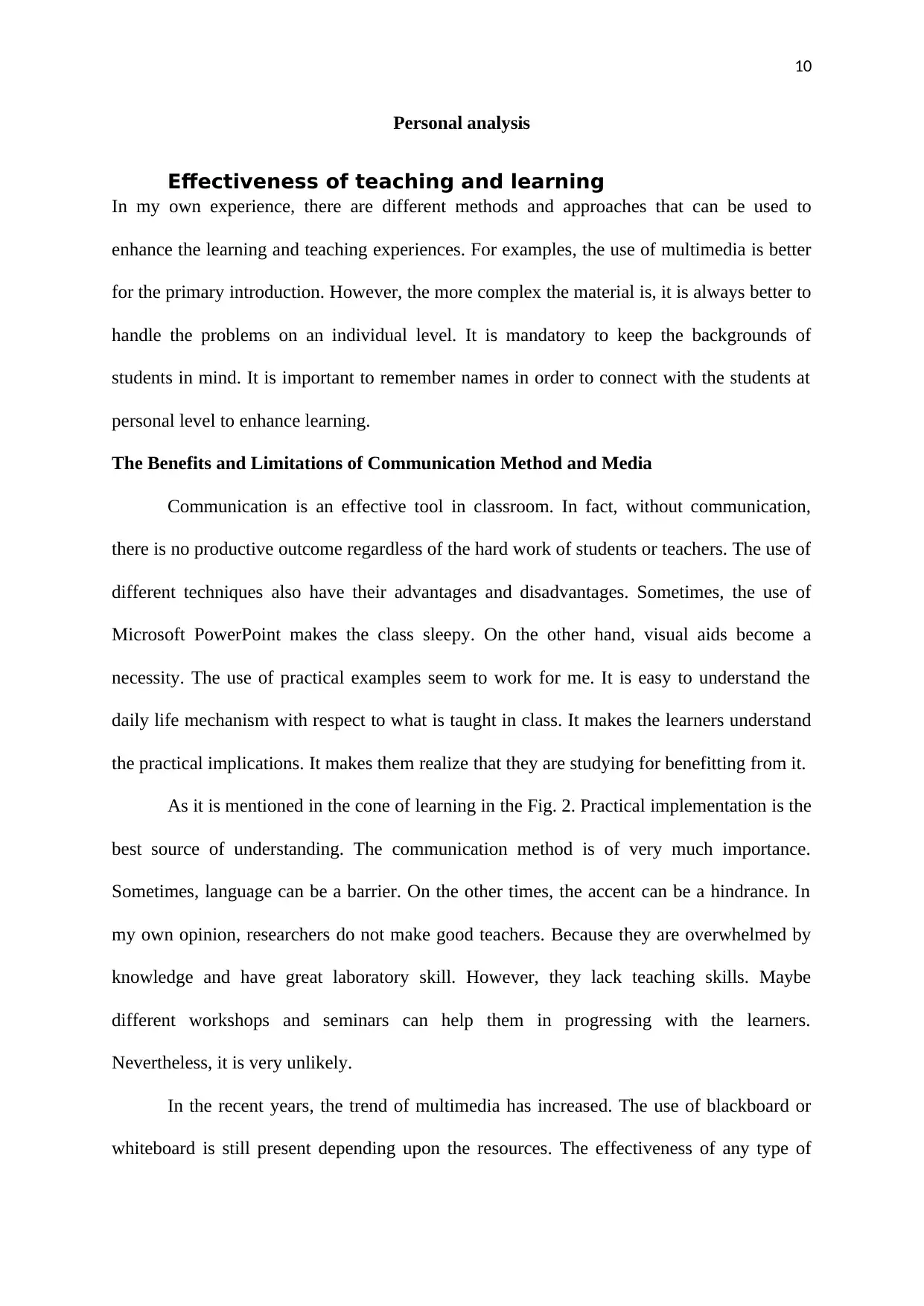
10
Personal analysis
Effectiveness of teaching and learning
In my own experience, there are different methods and approaches that can be used to
enhance the learning and teaching experiences. For examples, the use of multimedia is better
for the primary introduction. However, the more complex the material is, it is always better to
handle the problems on an individual level. It is mandatory to keep the backgrounds of
students in mind. It is important to remember names in order to connect with the students at
personal level to enhance learning.
The Benefits and Limitations of Communication Method and Media
Communication is an effective tool in classroom. In fact, without communication,
there is no productive outcome regardless of the hard work of students or teachers. The use of
different techniques also have their advantages and disadvantages. Sometimes, the use of
Microsoft PowerPoint makes the class sleepy. On the other hand, visual aids become a
necessity. The use of practical examples seem to work for me. It is easy to understand the
daily life mechanism with respect to what is taught in class. It makes the learners understand
the practical implications. It makes them realize that they are studying for benefitting from it.
As it is mentioned in the cone of learning in the Fig. 2. Practical implementation is the
best source of understanding. The communication method is of very much importance.
Sometimes, language can be a barrier. On the other times, the accent can be a hindrance. In
my own opinion, researchers do not make good teachers. Because they are overwhelmed by
knowledge and have great laboratory skill. However, they lack teaching skills. Maybe
different workshops and seminars can help them in progressing with the learners.
Nevertheless, it is very unlikely.
In the recent years, the trend of multimedia has increased. The use of blackboard or
whiteboard is still present depending upon the resources. The effectiveness of any type of
Personal analysis
Effectiveness of teaching and learning
In my own experience, there are different methods and approaches that can be used to
enhance the learning and teaching experiences. For examples, the use of multimedia is better
for the primary introduction. However, the more complex the material is, it is always better to
handle the problems on an individual level. It is mandatory to keep the backgrounds of
students in mind. It is important to remember names in order to connect with the students at
personal level to enhance learning.
The Benefits and Limitations of Communication Method and Media
Communication is an effective tool in classroom. In fact, without communication,
there is no productive outcome regardless of the hard work of students or teachers. The use of
different techniques also have their advantages and disadvantages. Sometimes, the use of
Microsoft PowerPoint makes the class sleepy. On the other hand, visual aids become a
necessity. The use of practical examples seem to work for me. It is easy to understand the
daily life mechanism with respect to what is taught in class. It makes the learners understand
the practical implications. It makes them realize that they are studying for benefitting from it.
As it is mentioned in the cone of learning in the Fig. 2. Practical implementation is the
best source of understanding. The communication method is of very much importance.
Sometimes, language can be a barrier. On the other times, the accent can be a hindrance. In
my own opinion, researchers do not make good teachers. Because they are overwhelmed by
knowledge and have great laboratory skill. However, they lack teaching skills. Maybe
different workshops and seminars can help them in progressing with the learners.
Nevertheless, it is very unlikely.
In the recent years, the trend of multimedia has increased. The use of blackboard or
whiteboard is still present depending upon the resources. The effectiveness of any type of
Paraphrase This Document
Need a fresh take? Get an instant paraphrase of this document with our AI Paraphraser
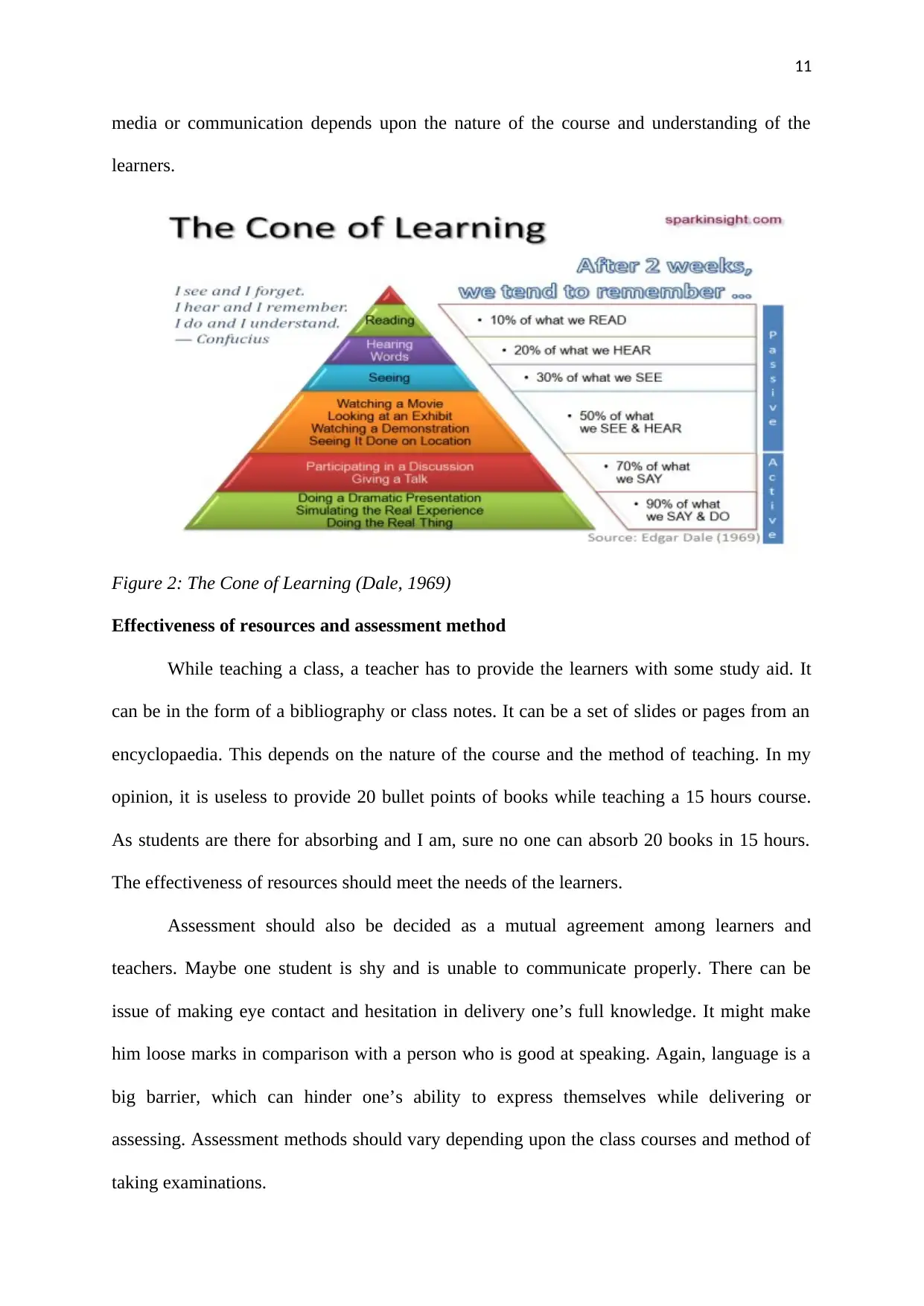
11
media or communication depends upon the nature of the course and understanding of the
learners.
Figure 2: The Cone of Learning (Dale, 1969)
Effectiveness of resources and assessment method
While teaching a class, a teacher has to provide the learners with some study aid. It
can be in the form of a bibliography or class notes. It can be a set of slides or pages from an
encyclopaedia. This depends on the nature of the course and the method of teaching. In my
opinion, it is useless to provide 20 bullet points of books while teaching a 15 hours course.
As students are there for absorbing and I am, sure no one can absorb 20 books in 15 hours.
The effectiveness of resources should meet the needs of the learners.
Assessment should also be decided as a mutual agreement among learners and
teachers. Maybe one student is shy and is unable to communicate properly. There can be
issue of making eye contact and hesitation in delivery one’s full knowledge. It might make
him loose marks in comparison with a person who is good at speaking. Again, language is a
big barrier, which can hinder one’s ability to express themselves while delivering or
assessing. Assessment methods should vary depending upon the class courses and method of
taking examinations.
media or communication depends upon the nature of the course and understanding of the
learners.
Figure 2: The Cone of Learning (Dale, 1969)
Effectiveness of resources and assessment method
While teaching a class, a teacher has to provide the learners with some study aid. It
can be in the form of a bibliography or class notes. It can be a set of slides or pages from an
encyclopaedia. This depends on the nature of the course and the method of teaching. In my
opinion, it is useless to provide 20 bullet points of books while teaching a 15 hours course.
As students are there for absorbing and I am, sure no one can absorb 20 books in 15 hours.
The effectiveness of resources should meet the needs of the learners.
Assessment should also be decided as a mutual agreement among learners and
teachers. Maybe one student is shy and is unable to communicate properly. There can be
issue of making eye contact and hesitation in delivery one’s full knowledge. It might make
him loose marks in comparison with a person who is good at speaking. Again, language is a
big barrier, which can hinder one’s ability to express themselves while delivering or
assessing. Assessment methods should vary depending upon the class courses and method of
taking examinations.
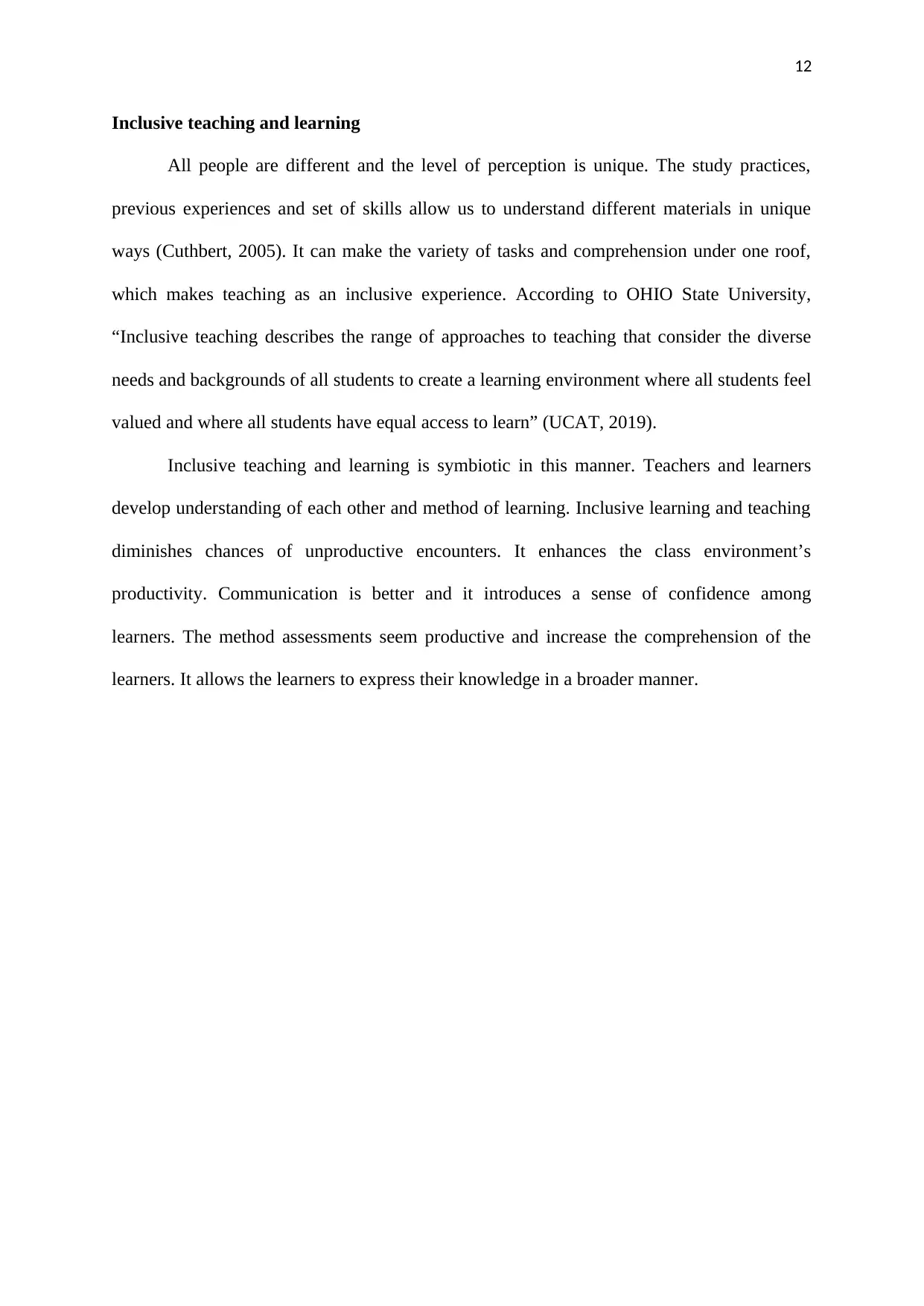
12
Inclusive teaching and learning
All people are different and the level of perception is unique. The study practices,
previous experiences and set of skills allow us to understand different materials in unique
ways (Cuthbert, 2005). It can make the variety of tasks and comprehension under one roof,
which makes teaching as an inclusive experience. According to OHIO State University,
“Inclusive teaching describes the range of approaches to teaching that consider the diverse
needs and backgrounds of all students to create a learning environment where all students feel
valued and where all students have equal access to learn” (UCAT, 2019).
Inclusive teaching and learning is symbiotic in this manner. Teachers and learners
develop understanding of each other and method of learning. Inclusive learning and teaching
diminishes chances of unproductive encounters. It enhances the class environment’s
productivity. Communication is better and it introduces a sense of confidence among
learners. The method assessments seem productive and increase the comprehension of the
learners. It allows the learners to express their knowledge in a broader manner.
Inclusive teaching and learning
All people are different and the level of perception is unique. The study practices,
previous experiences and set of skills allow us to understand different materials in unique
ways (Cuthbert, 2005). It can make the variety of tasks and comprehension under one roof,
which makes teaching as an inclusive experience. According to OHIO State University,
“Inclusive teaching describes the range of approaches to teaching that consider the diverse
needs and backgrounds of all students to create a learning environment where all students feel
valued and where all students have equal access to learn” (UCAT, 2019).
Inclusive teaching and learning is symbiotic in this manner. Teachers and learners
develop understanding of each other and method of learning. Inclusive learning and teaching
diminishes chances of unproductive encounters. It enhances the class environment’s
productivity. Communication is better and it introduces a sense of confidence among
learners. The method assessments seem productive and increase the comprehension of the
learners. It allows the learners to express their knowledge in a broader manner.
⊘ This is a preview!⊘
Do you want full access?
Subscribe today to unlock all pages.

Trusted by 1+ million students worldwide
1 out of 17
Related Documents
Your All-in-One AI-Powered Toolkit for Academic Success.
+13062052269
info@desklib.com
Available 24*7 on WhatsApp / Email
![[object Object]](/_next/static/media/star-bottom.7253800d.svg)
Unlock your academic potential
Copyright © 2020–2025 A2Z Services. All Rights Reserved. Developed and managed by ZUCOL.


